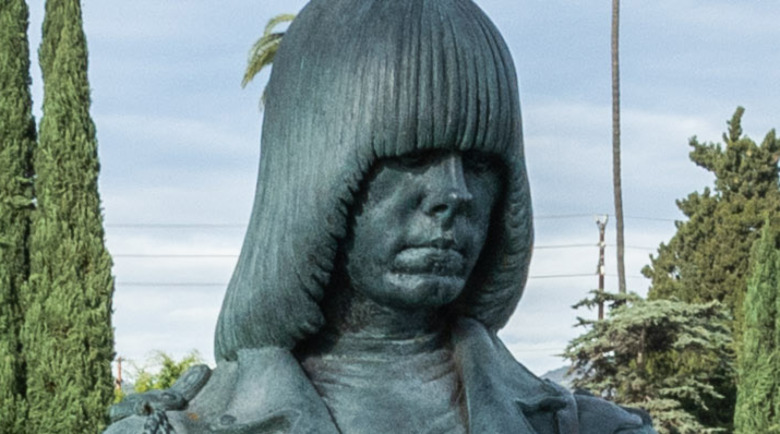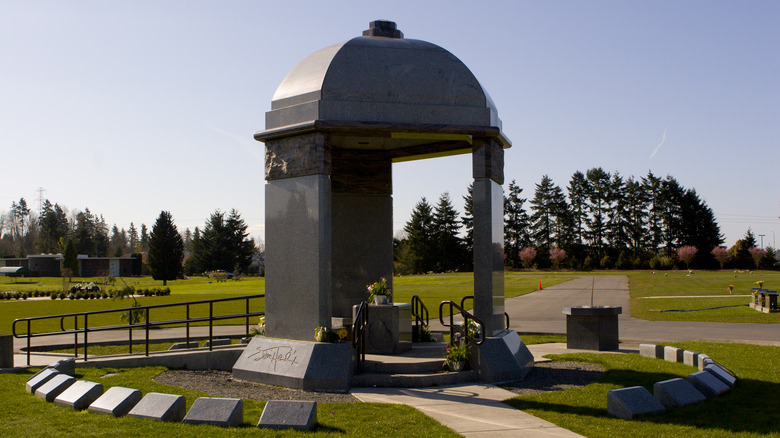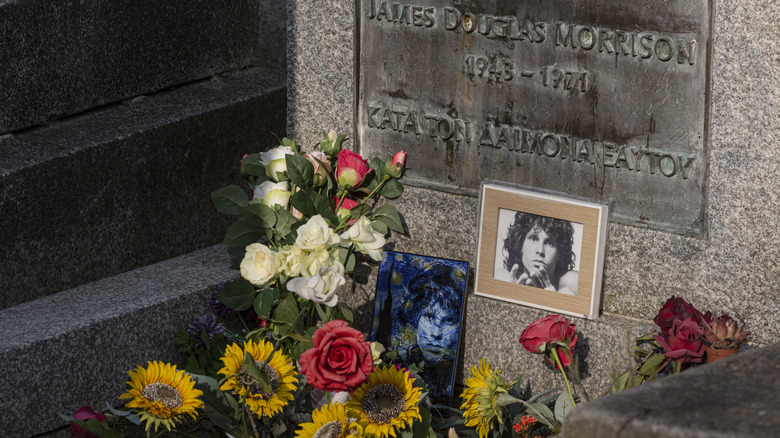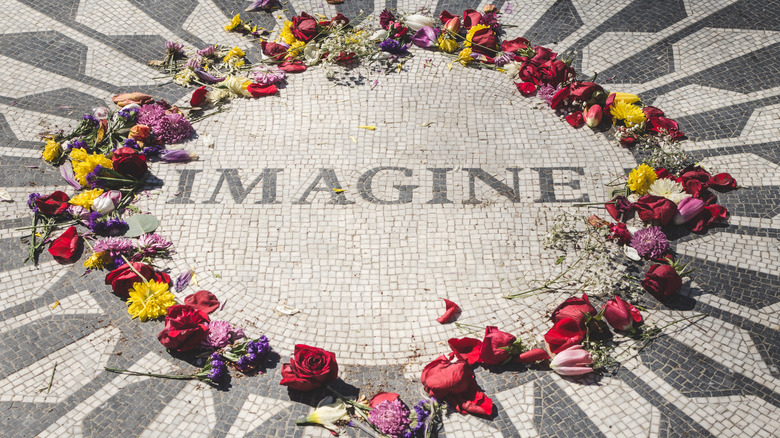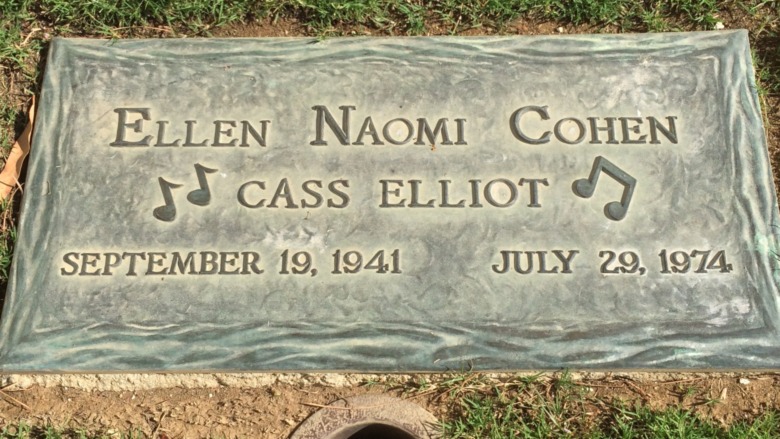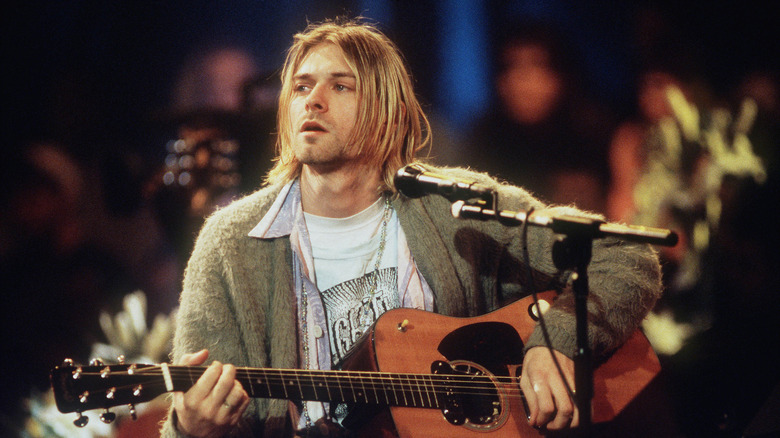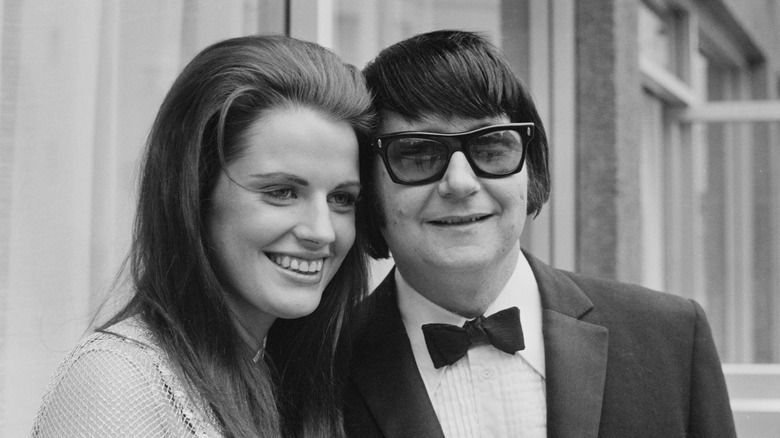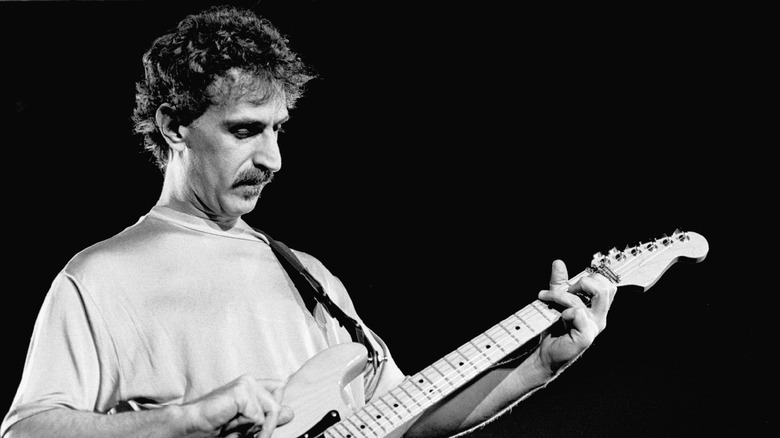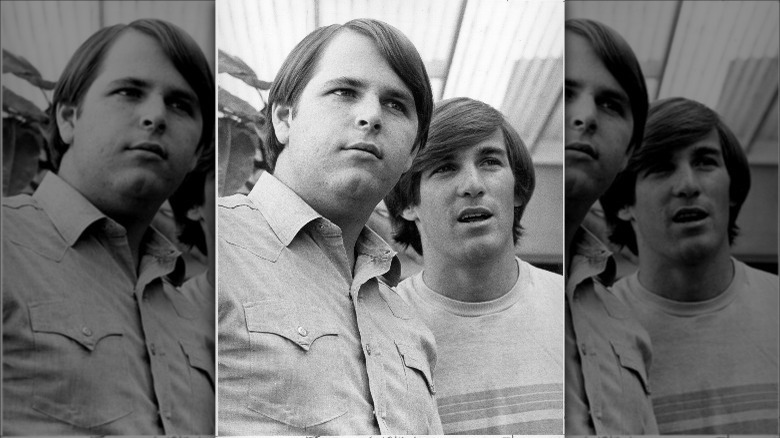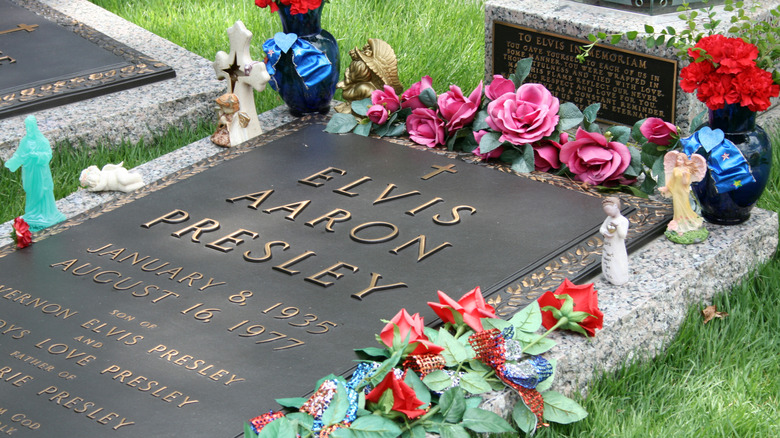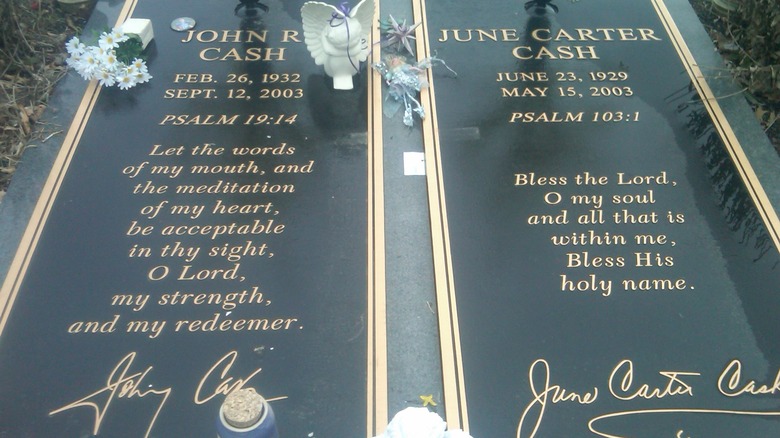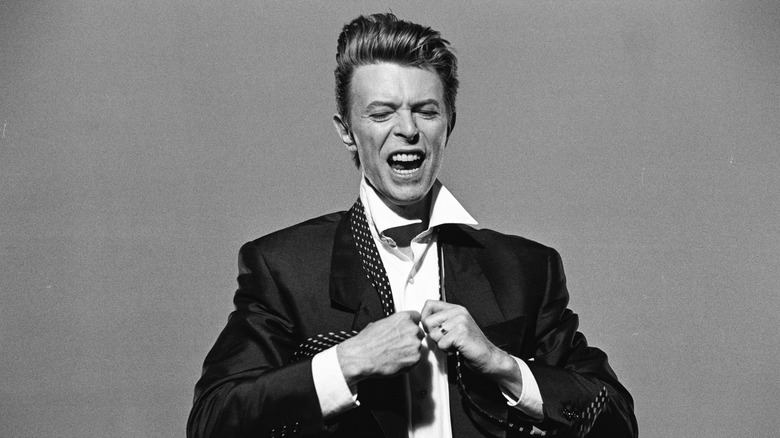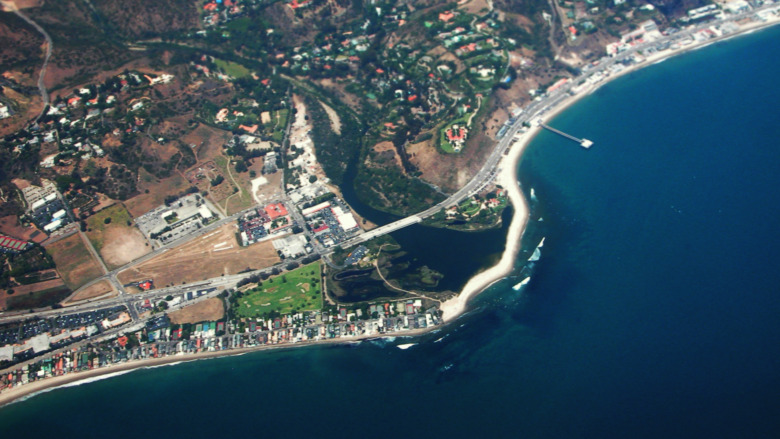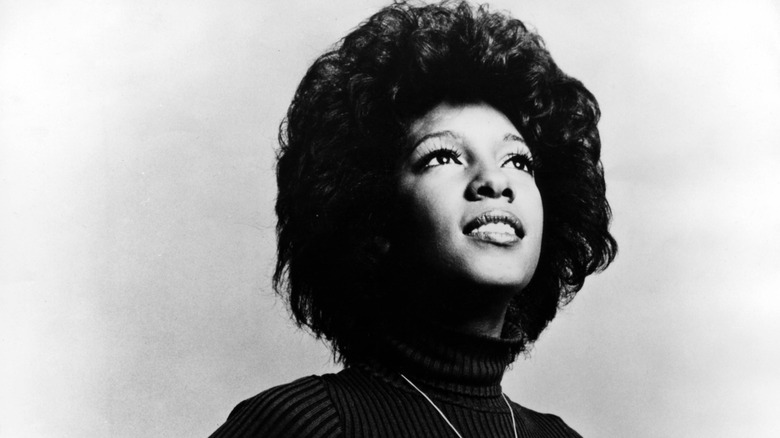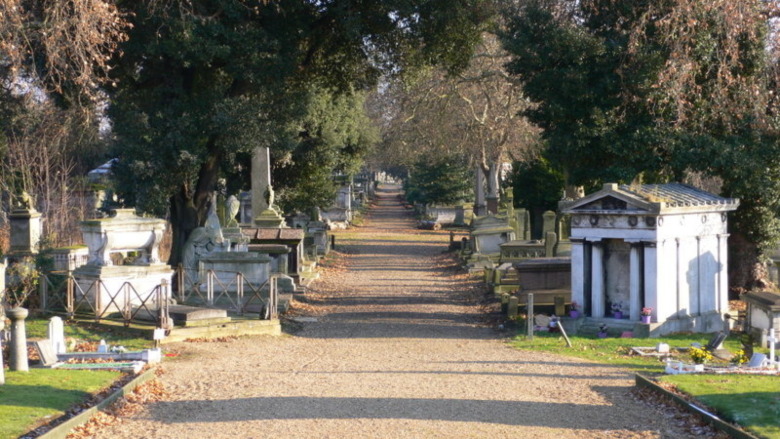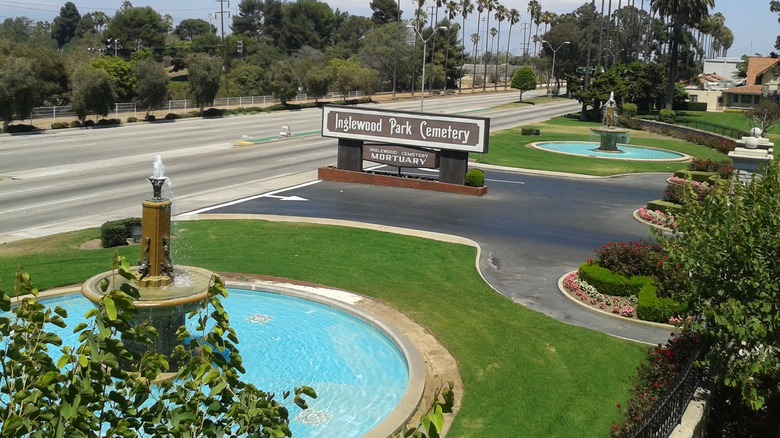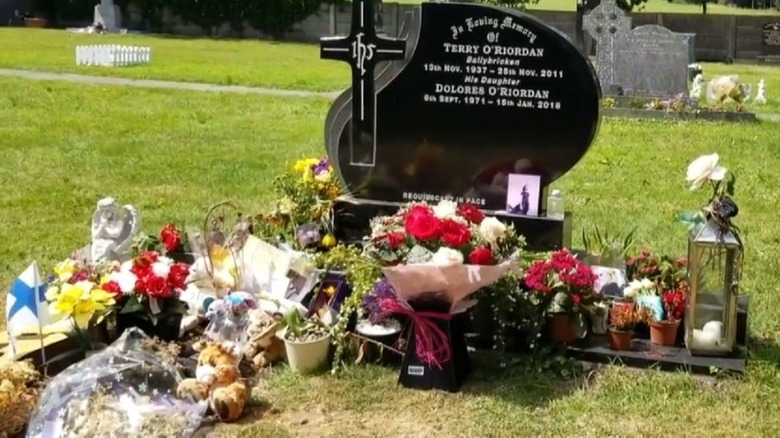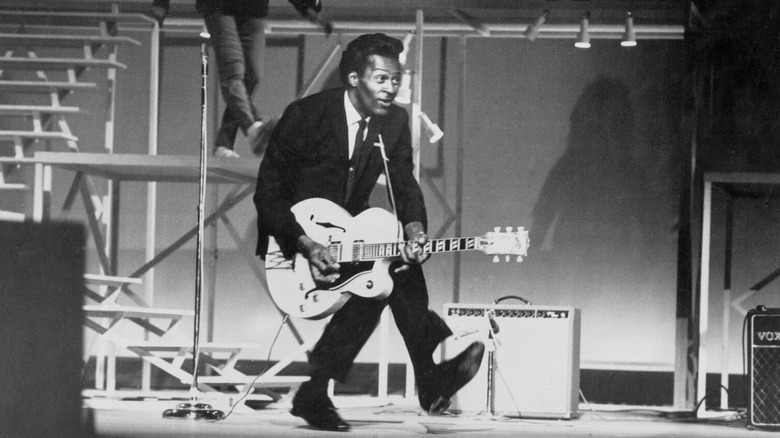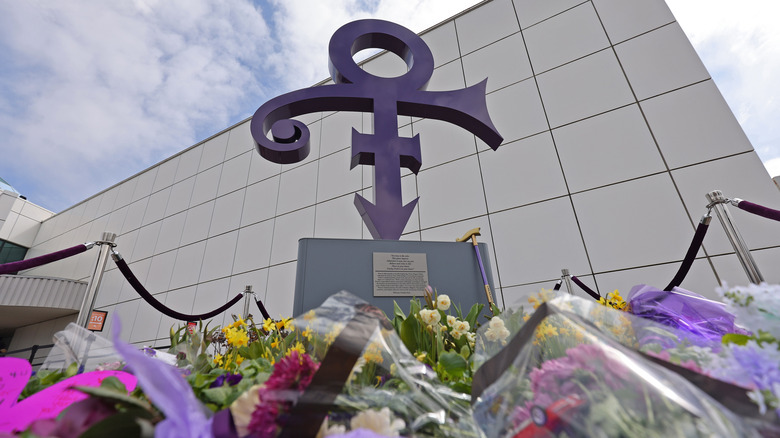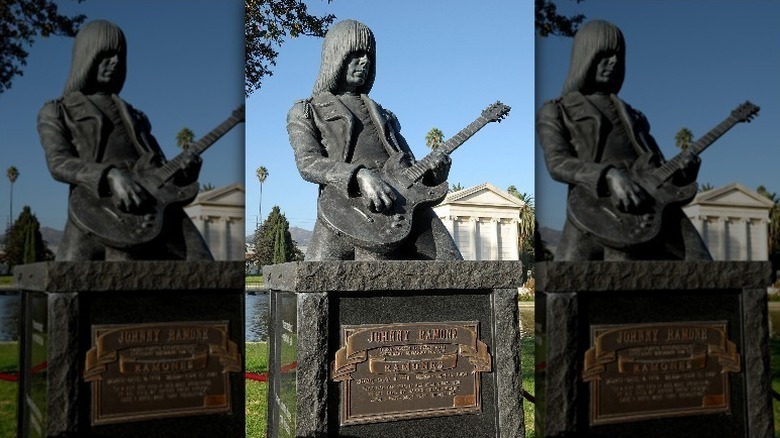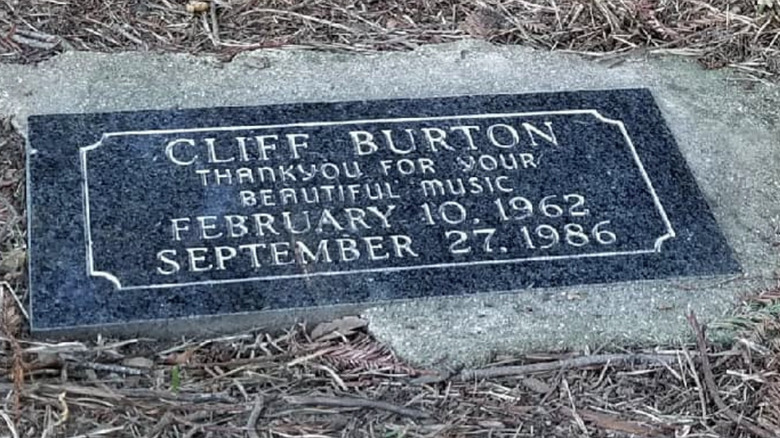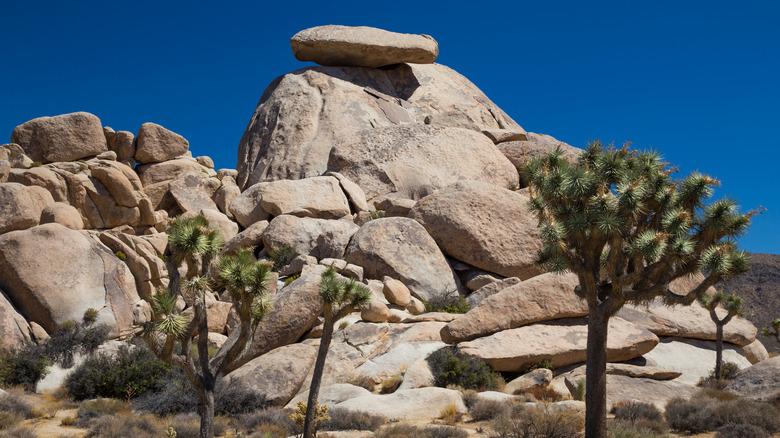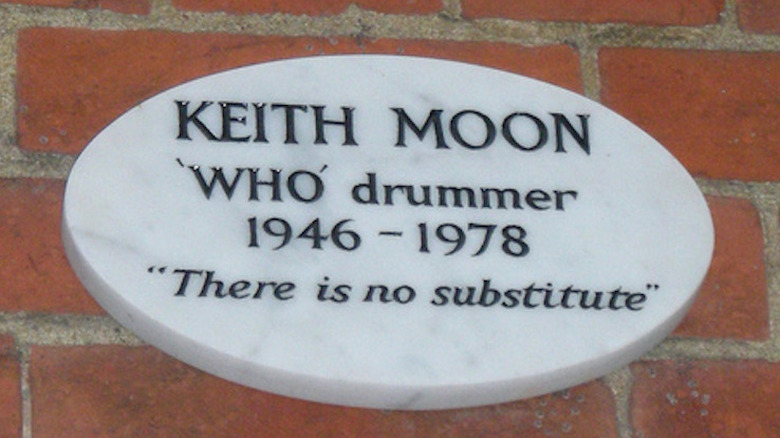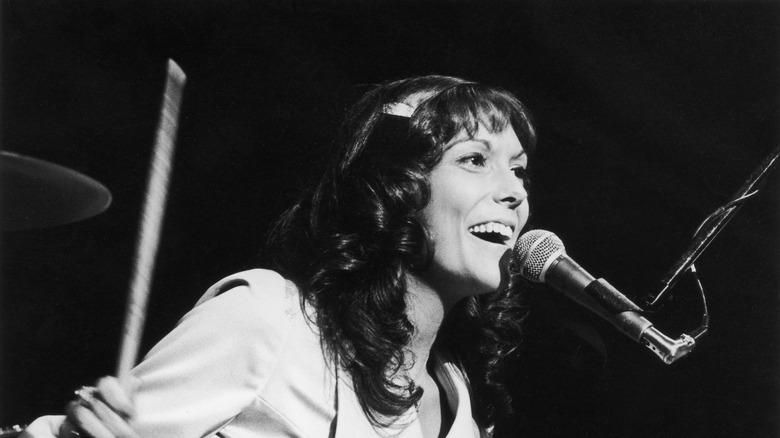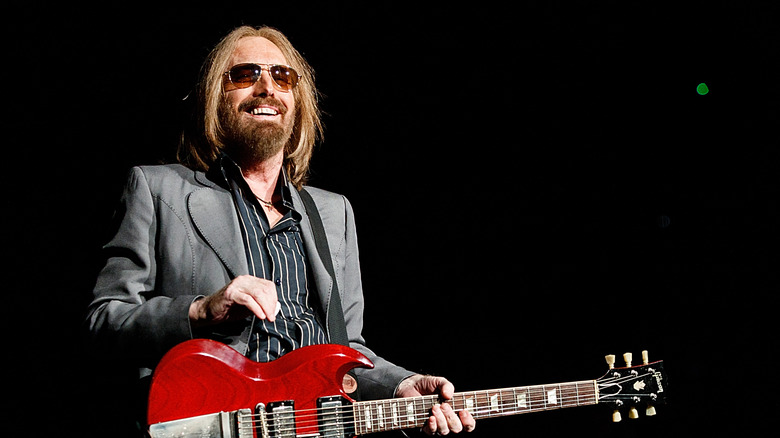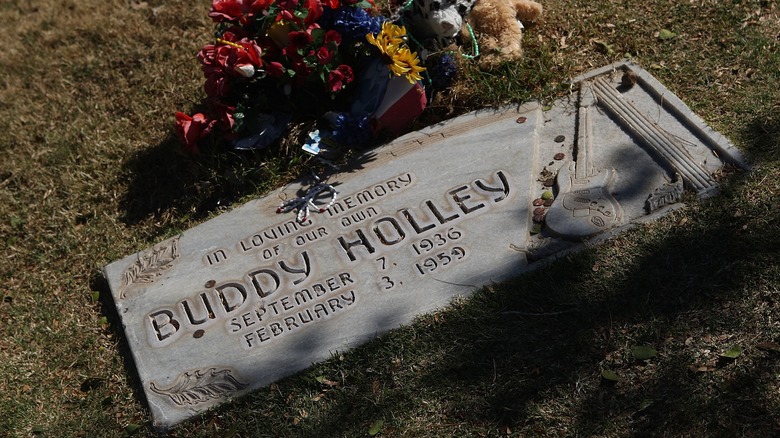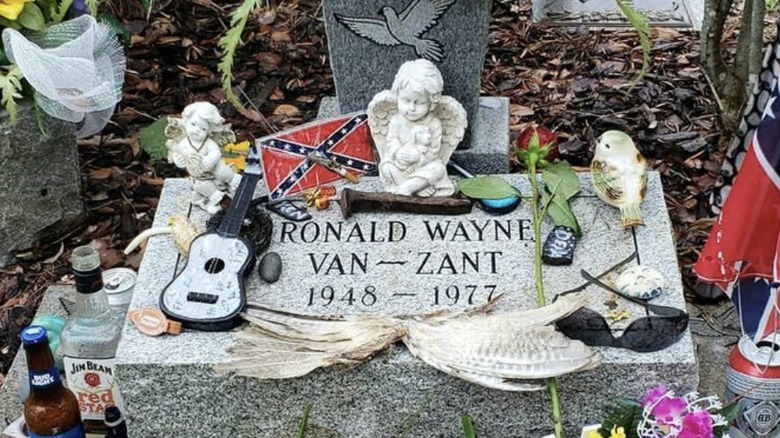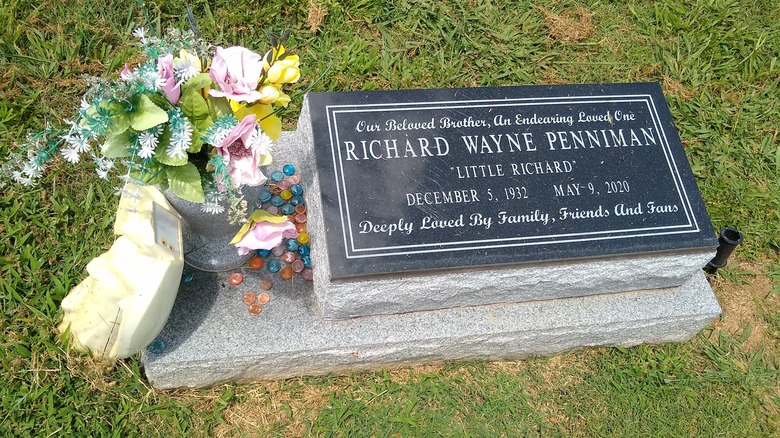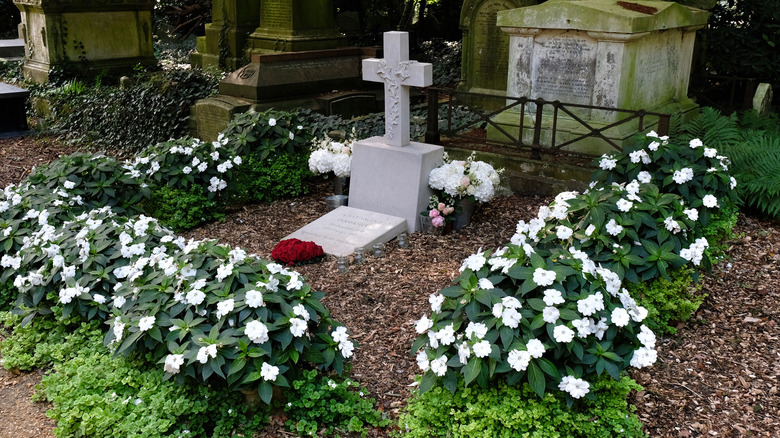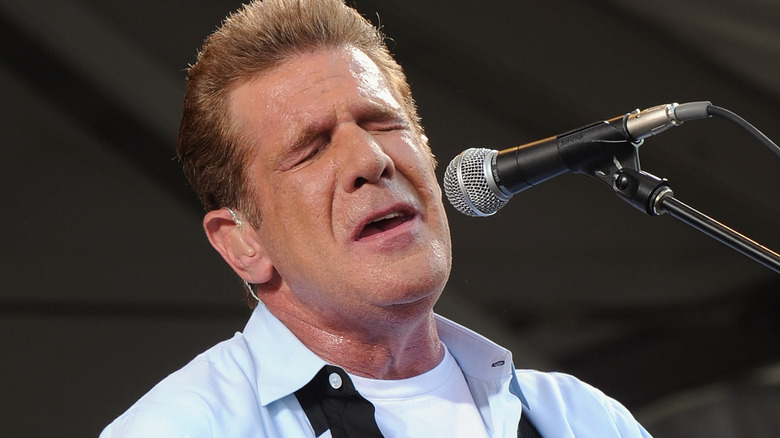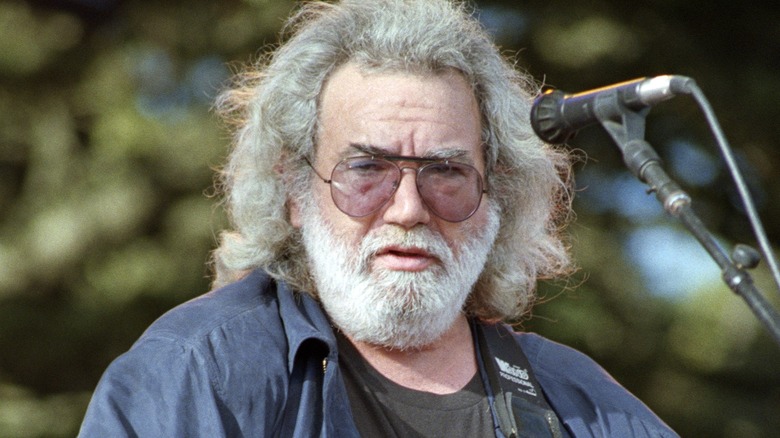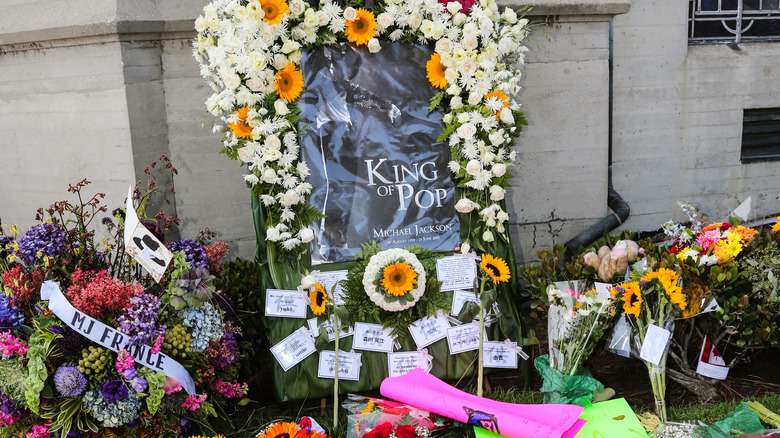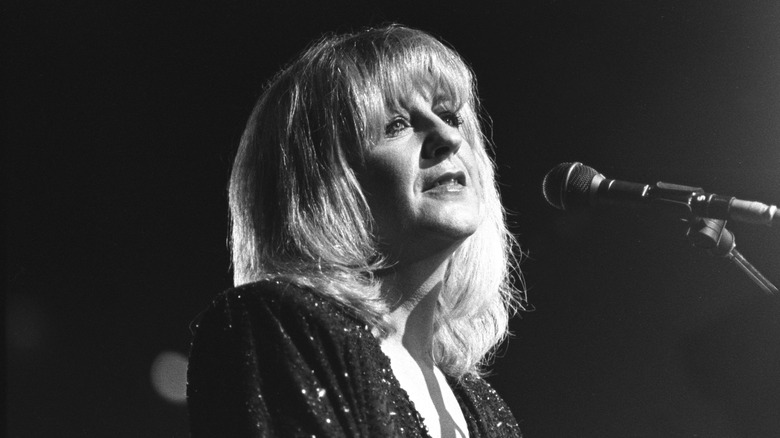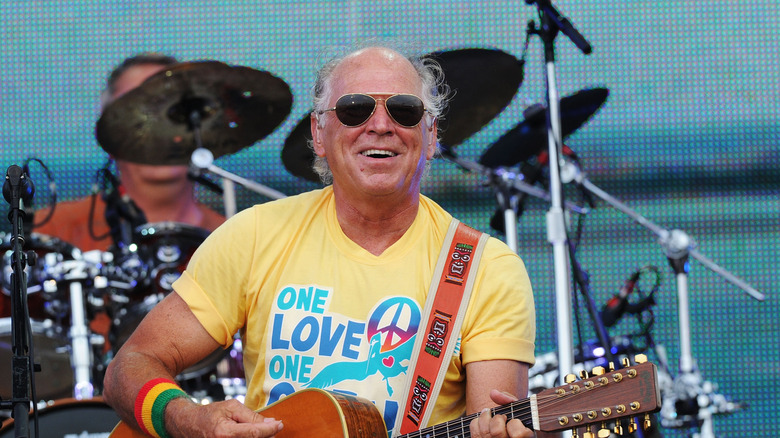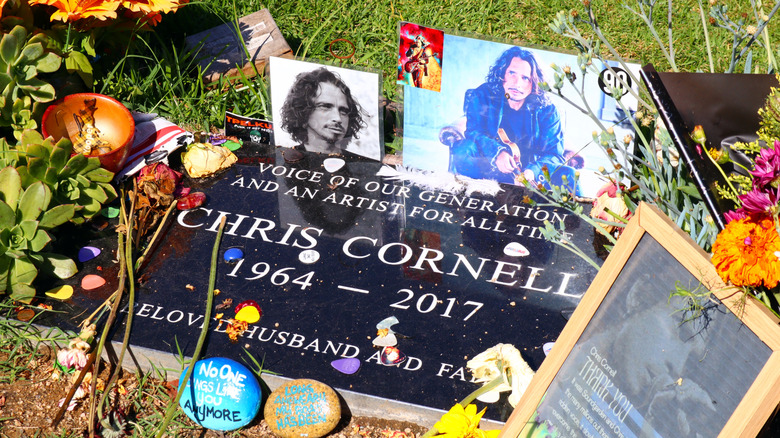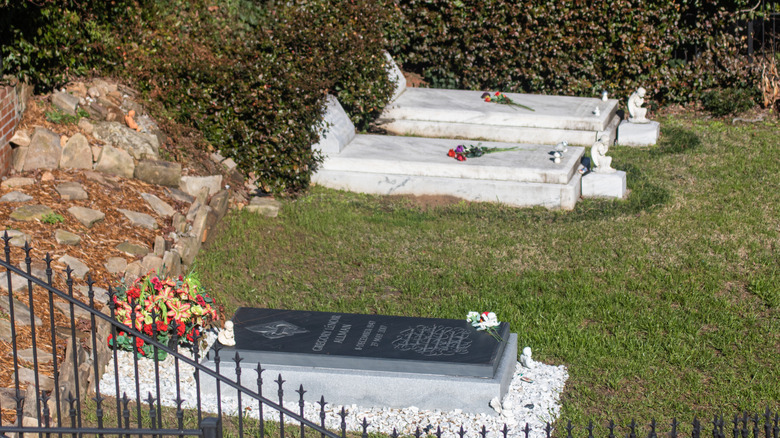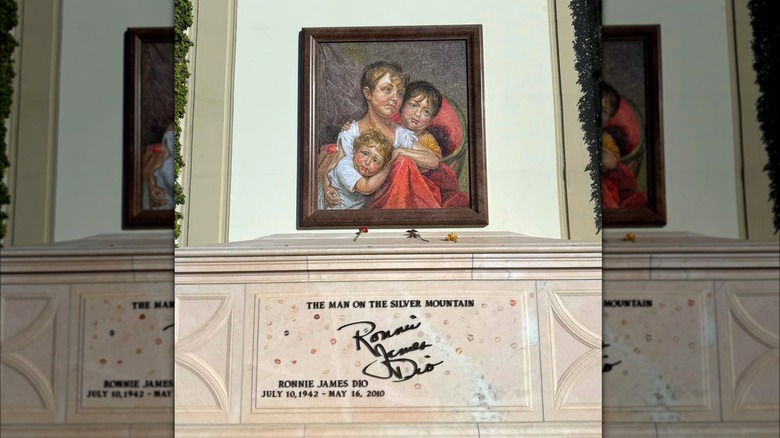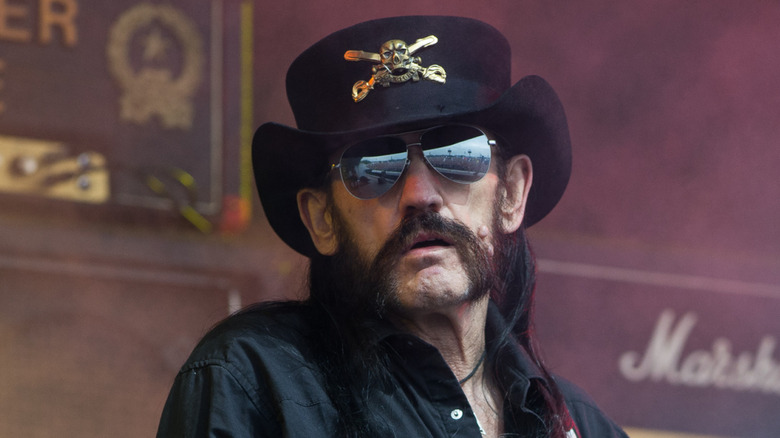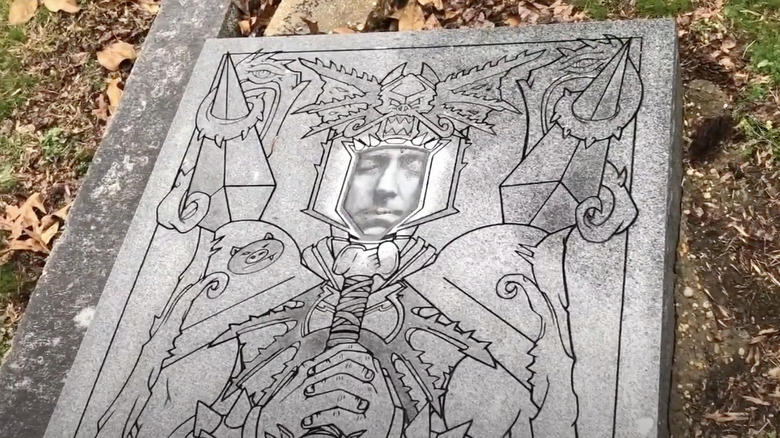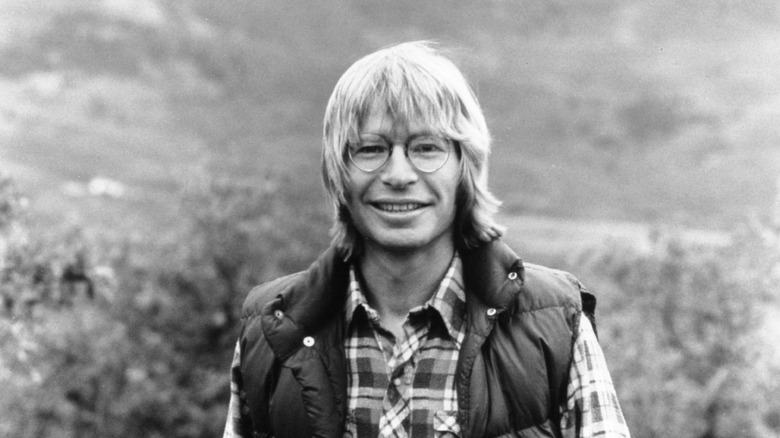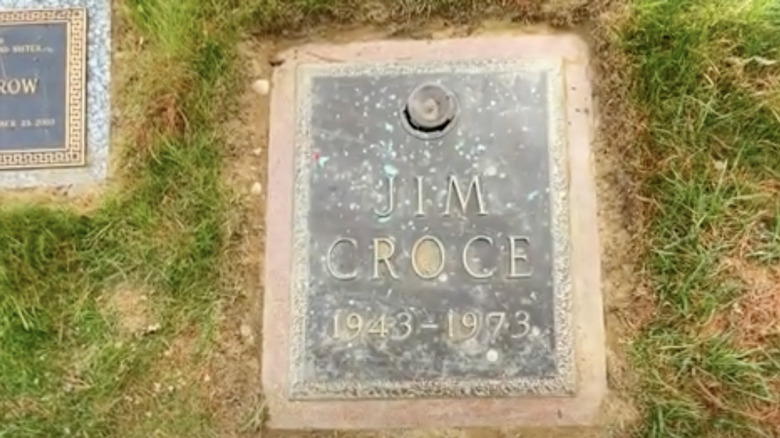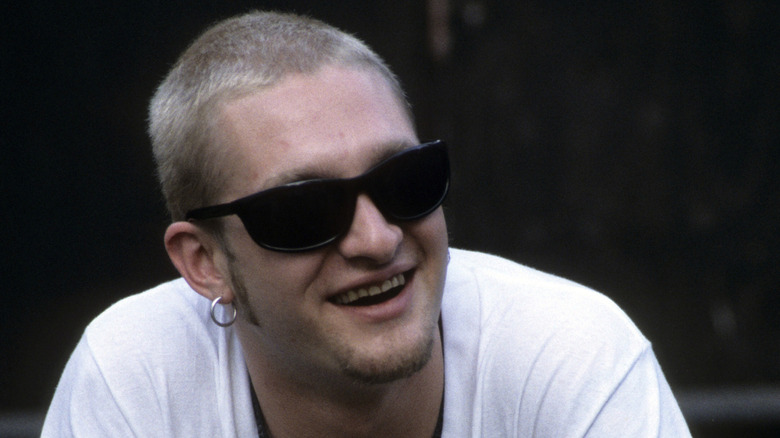Where These Legendary Rock Stars Are Buried
If you missed the chance to see some of your favorite musical icons perform live, visiting the place where they're buried feels like the most appropriate way to pay your respects (other than performing substandard covers of their best songs in your bedroom). The rock star life takes a toll, and it claimed many of its greatest idols well before their time. On top of that, rock stars are also subject to accidents and to the vicious whims of nature, like the rest of us.
Anyone thinking of doing a tour to cover as many rock star burial sites as possible will probably want to start in Los Angeles, which lives up to its name as the City of Angels in that many members of music royalty are spending the rest of time there. However, there's always room for a few mavericks in music. From Paris to St. Louis to Bali, here's where these legendary rock stars are buried.
Jimi Hendrix was moved to a larger memorial
Some still regard Jimi Hendrix's death at just 27 on September 18, 1970, as not only tragic but suspicious. The guitar legend died in a room at London's Samarkand Hotel that belonged to his on-again-off-again romantic partner Monika Dannemann. Details of the hours leading up to Hendrix's death are vague, with Dannemann and others changing their accounts multiple times. Hendrix apparently took strong sleeping pills combined with red wine, which caused him to vomit but not wake up, until he ultimately choked to death. The coroner returned an open verdict, which has only increased suspicion.
Hendrix's burial was also contentious. In 1970, he was buried in a plot at the Greenwood Memorial Park Cemetery in his hometown of Renton, Washington, marked by a simple gravestone reading "Forever in Our Hearts." But in 1999, his family announced plans to build a 27-foot stone memorial in the cemetery, partly funded by fans, complete with granite pillars, a domed roof, and sculptures. Hendrix's friends protested that digging him up was disrespectful, but in 2002, the memorial was completed, and Hendrix was moved there to lie alongside his father, stepmother, and grandmother.
Janis Joplin's ashes were scattered in the Pacific
Janis Joplin died of an accidental heroin overdose on October 4, 1970 — three weeks after the death of Jimi Hendrix and nine months before Jim Morrison's death. The New York Times reported that two days later, Joplin was cremated at Los Angeles' Westwood Village Mortuary, with just 10 people in attendance. Her ashes were scattered in the Pacific Ocean, off the coast of Marin County (pictured), north of San Francisco, as Joplin had apparently requested.
You can't visit the exact spot where Joplin was laid to rest, but you can still visit the room where she died in the Landmark Hotel, now the Highland Gardens Hotel, on Franklin and North Sycamore Avenues in Hollywood. The extra-morbid can actually sleep in that room, number 105, according to Atlas Obscura.
Even if you didn't specifically try to book the room, you'd learn about its connection to Joplin when you went to hang up your clothes. In addition to a brass plaque, the closet contains fans' scribbled tributes to the singer.
Jim Morrison still draws crowds
Jim Morrison was only 27 and already in rock star retirement when he died in his apartment at 17 rue Beautreillis in Paris on July 3, 1971. The official story is that he was found dead in his bathtub from heart failure. But some supposed witnesses have since come forward to say that he fatally overdosed on heroin in a nightclub toilet cubicle, and was carried, already dead, back to his apartment by a pair of drug dealers.
Morrison's grave at Paris' Père Lachaise Cemetery is one of the most famous in the world — which is impressive when you consider that he's not even the most prestigious person in the cemetery. Père Lachaise is also the eternal home of world-renowned figures including Oscar Wilde, Marcel Proust, Edith Piaf, and Frédéric Chopin.
But crowds still gather to visit Morrison's impressive shrine, which includes a bronze plaque engraved with his name, dates, and an ancient Greek epitaph chosen by his father that reads "KATA TON DAIMONA EAUTOU." This is usually roughly translated as "True to his own spirit" — but it could also mean "True to his own demons," a potential reference to the troubles that drove Morrison to Paris in the first place.
John Lennon has a permanent home in Central Park
One of the most famous Liverpudlians in history, not to mention an icon of Swingin' '60s London, John Lennon left his home country for New York in 1971. Having married artist Yoko Ono two years earlier, Lennon hoped that the bustling, celebrity-filled city would shield him from the constant attention that comes with Beatles-levels of fame. Instead, nine years later, on December 8, 1980, Lennon was shot dead outside his home at the Dakota apartment and hotel complex by Mark Chapman. Chapman later said that he'd chosen to kill Lennon because of his fame, believing it would in turn bring him "self-glory."
On October 9, 1985 — which would have been Lennon's 45th birthday — an area of Central Park opposite the Dakota was dedicated to the musician. According to the Central Park Conservancy, Lennon had enjoyed many walks in the tranquil space. Renamed Strawberry Fields in tribute to one of Lennon's favorite Beatles songs, it features a mosaic with the word "Imagine" at the center, which was presented as a gift by the city of Naples, Italy. Designed to inspire reflection, it's one of the park's designated Quiet Zones. The New York Times reports that Ono was involved in the creation of the memorial, and it's believed that she scattered Lennon's ashes in the area.
George Harrison requested a Hindu burial
Unlike those of his rock star peers who died suddenly, Beatle George Harrison spent nearly four years being treated for cancer, dying aged 58 on November 29, 2001. He was diagnosed with throat cancer in 1997, and then with lung cancer in 1999. That year, he also survived being stabbed multiple times by a home intruder. In 2001, Harrison had surgery to treat the lung cancer, and underwent more radiation to treat a brain tumor, but ultimately died from the disease.
Harrison was a follower of the Hare Krishna movement, a branch of Hinduism. In accordance with Hindu beliefs, he was cremated shortly after his death at the Hollywood Forever Memorial Park. Hare Krishna spokesmen told the press that Harrison's wife Olivia and son Dhani would be scattering his ashes in the Ganges (a sacred river in Hindu theology) in Varanasi, India, and at the convergence of the Ganges and the Yamuna. Crowds of fans and press headed to the city, only for the society to retract its previous comments. It's believed that Harrison's family did scatter his ashes in the rivers, but that they waited until they could do it more privately.
Cass Elliot died in a 'cursed' London apartment but was buried in California
The most famous detail about the death of Mamas and Papas singer "Mama Cass" Elliot, on July 28, 1974, is wrong. She did not die from choking on a ham sandwich. As People explains, that was a rumor put out by her manager Allan Carr, who was worried that Elliot had died from a drug overdose and didn't want anyone to know.
Unfortunately, the ham sandwich story has since been twisted into cruel jokes about Elliot's weight. In fact, Elliot died from heart failure, potentially brought on by the crash diets she'd long experimented with because she was so mocked for her size, as well as her heavy drug use.
Just 32, Elliot died in London's Mayfair at an apartment owned by musician Harry Nilsson, who was out of the country. Her body was flown back to California, where she was buried at Los Angeles' Mount Sinai Memorial Park, marked with a simple plaque. Four years later, Keith Moon, drummer of The Who, died of a clomethiazole overdose at the same apartment. Disturbed at the deaths of his friends, Nilsson sold the apartment — to Moon's bandmate, Pete Townshend.
Kurt Cobain's ashes were divided
The story of Nirvana frontman and grunge icon Kurt Cobain's death is well known, even if certain aspects are disputed by some people. The most accepted story is that Cobain died by suicide on April 5, 1994, in his home in Seattle, Washington. His body was found three days later.
After Cobain's death, his widow Courtney Love had his body cremated. As Esquire reported in 1996, the couple had been "intermittent Buddhists," and Love wanted to give Cobain's remains the appropriate spiritual treatment. She divided the ashes, scattering some into the Wishkah River near Cobain's childhood home, and keeping some herself, reportedly in a bear-shaped handbag alongside her wedding dress. She took these ashes to a Buddhist monastery in Ithaca, New York, and left some with the monks for consecration. The monks mixed the ashes with clay and turned them into tsatsas — described by Esquire as "cone-shaped sculptures three inches tall and painted gold," intended to be kept in a small shrine.
Love took the remaining ashes, in the bag, back home. She kept them in the closet, but in 2008, she reported that they had been stolen, apparently by someone she knew, then months later, backtracked and said they weren't stolen after all, per Express.
To find Roy Orbison, look for his wife
Singer, songwriter, and guitarist Roy Orbison was only 51 when he died of a heart attack on December 6, 1988, but he'd been through multiple tragedies. In 1966, his first wife, Claudette Frady, was killed in a motorcycle crash. Two years later, two of their three sons, Roy Jr. and Anthony, died in a fire at their Nashville house while Orbison was on tour. Having made the top 10 nine times between 1960 and 1965, Orbison's career declined.
However, in between these three great losses, Orbison met the woman who became his second wife: teenage pre-med student Barbara Jakobs. The two married in 1969 and went on to have two sons together, while also raising Orbison's surviving son, Wesley, from his first marriage. In the 1980s, Jakobs became Orbison's manager, and he experienced a comeback. In 1987, he was inducted into the Rock & Roll Hall of Fame, and he'd formed a supergroup, the Traveling Wilburys, which also included Tom Petty, George Harrison, and Bob Dylan, shortly before he died suddenly.
Orbison is buried in Westwood Memorial Park in Los Angeles, but as of 2018, his grave was unmarked. Instead, look for Jakobs: According to The Hollywood Reporter, when she died in 2011, she was buried next to him, with a marker. Claudette Frady, Roy Jr., and Anthony are buried in Nashville.
Good luck finding Frank Zappa
If you know Frank Zappa's tragic real-life story, you'll know that after a full-on life pushing boundaries and doing things, as Sinatra would say, his way, Zappa died of prostate cancer on December 4, 1993, aged 52. His family announced his death with the statement "Composer Frank Zappa left for his final tour just before 6 p.m. Saturday," via Biography.
Zappa was buried in Westwood Memorial Park in Los Angeles, a surprisingly conventional choice for someone who determinedly bucked convention at every opportunity. The cemetery is the final home of many superstars from movies, music, and the arts, including Marilyn Monroe, Dean Martin, Jack Lemmon, Truman Capote, Kirk Douglas, and Natalie Wood. According to the LA Times, in 2020, a single burial plot there cost $745,000.
There is one thing that's unusual about Zappa's resting place: He's buried in an unmarked grave, supposedly near the also-unmarked grave of Roy Orbison. His family hasn't given an exact reason for this, but it fits in with someone who liked to take the less-trodden path.
Beach Boys Dennis and Carl Wilson got the celebrity treatment
The Beach Boys lost more than a bandmate when Dennis Wilson, the band's drummer, drowned, aged 39, on December 28, 1983. In addition to being the middle brother of Brian and Carl, he was Mike Love's cousin. On the day he died, Dennis had been drinking and hanging out with friends on their boat at the Marina del Rey Harbor. According to People, they happened to be right next to the slip where he'd docked his own boat years prior and thrown several things overboard, so he was jumping in and getting a kick out of finding his old items. Eventually, he went underwater and never resurfaced. The week after his death, President Ronald Reagan intervened so that Dennis' body could be buried at sea, per his wishes, an honor usually reserved for veterans of the Navy or Coast Guard.
Fifteen years later, Dennis' younger brother Carl died. He'd been diagnosed with cancer in 1997, and continued to play with the band while receiving treatment. In December that year, the Wilson brothers' mother, Audree, died, aged 80, and was buried in Los Angeles' Westwood Memorial Park. Her grave marker identifies her as "The Original Surfer Girl." Two months later, on February 6, 1998, Carl died too, and was buried in the same cemetery.
Elvis Presley returned to Graceland after an attempted grave robbery
Elvis Presley struggled to find privacy while he was alive, and even after his death, people couldn't keep their hands off him. When Presley died of a heart attack on August 16, 1977, aged 42, the nation went into mourning. And in some cases, denial.
The day after Elvis' death, his father Vernon Presley allowed around 30,000 fans to view his son lying in state in Graceland. At the funeral procession the following day, Elvis was taken to Forest Hill Cemetery in a white hearse, followed by 17 white limousines, for a private ceremony. According to The Daily Beast, Vernon had wanted his son buried at Graceland, but it wasn't zoned for burials. Instead, Elvis was interred inside a steel-lined coffin weighing nearly 1,000 pounds, and placed in a large mausoleum next to his mother Gladys, which was sealed with a double layer of concrete, covered with a marble slab.
That wasn't the end of it, though. On August 29, three men were caught trying to steal Presley's body, with the intention of ransoming it. After that, the burial rules were waived, and Elvis and Gladys were returned to Graceland. When Vernon died in 1979, he was buried next to them. But some have accused Vernon of orchestrating the attempted grave robbery, to ensure Elvis would be moved back to Graceland.
Johnny Cash is buried next to June Carter Cash — of course
One of music's greatest love stories started in the Grand Ole Opry and ended less than 20 miles away in Hendersonville Memory Gardens. In 1956, upcoming country star Johnny Cash met already-famous June Carter backstage at the famous Nashville venue. It wasn't supposed to be love at first sight: Both were married to different people. But that night, legend has it that Cash told Carter he was going to marry her.
Their professional and personal relationship deepened in the '60s, when the pair started touring together. Carter was inspired to write "Ring of Fire" about her illicit feelings for Cash. In 1966, Cash's first wife Vivian Liberto finally sued him for divorce, on grounds of infidelity and his addictions to various drugs and alcohol. Carter and Cash officially became a couple, but it was only when he proposed to her live on stage in front of 7,000 people in London, Ontario, on February 22, 1968, that she agreed to marry him — and she did, on March 1.
The couple was married for 35 years, until Carter's death, aged 73, on May 15, 2003. Cash died a few months later, on September 15. They are buried next to each other in a joint plot in Hendersonville Memory Gardens, Tennessee.
A psychic helped David Bowie plan ahead
If this list proves anything, it's that rock star life can end suddenly — but David Bowie wasn't worried. As his keyboardist Mike Garson explained to Billboard, Bowie had decades of advance warning, because in the 1970s, a psychic told him he would die at 69 or 70. Garson added, "[Bowie] didn't doubt it for a second ... [He] accepted it and planned his future out based on that." Bowie died on January 10, 2016, after what was described in an official statement as an "18-month battle with cancer." He'd turned 69 two days earlier.
That early warning (not to mention the cancer diagnosis) ensured Bowie had made his wishes clear. According to The New York Times, he asked that his ashes be cremated and scattered in Bali, following Buddhist rituals practiced on the island. Despite these very clear instructions and no evidence that his family had any intention of ignoring them, there were still rumors. E! Online reported that Bowie's widow Iman had given permission for some of his ashes to be scattered at 2016's Burning Man Festival. Bowie's son Duncan Jones immediately took to Twitter to shut down the claim, writing, "What people will do & say for attention never ceases to amaze me. Not true. Kind of a gross claim as well."
Eddie Van Halen had a most excellent request
Losing Eddie Van Halen in 2020 was a painful twist in a year that had already claimed so many lives. The guitarist rose to fame with his eponymous band — co-founded with his brother Alex — and revolutionized the sounds that could be created with an electric guitar.
Eddie Van Halen was 65 when he died of lung cancer on October 6, 2020. He had been diagnosed with throat cancer in 2000, but in 2004 said that the cancer was gone. A few weeks after his death, his son Wolfgang explained to "The Howard Stern Show" that his father had been diagnosed with advanced lung cancer in 2017, and given only six weeks to live. Eddie received treatment in Germany, which Wolfgang credits with the three years he survived after the diagnosis. But in 2019, following a motorcycle accident, Eddie was found to have a brain tumor.
It's believed that Wolfgang granted his father's final wishes and scattered his ashes off the coast of his hometown of Malibu, California.
Mary Wilson was buried next to her son
One third of the most famous girl group to emerge from Motown, Supreme Mary Wilson died suddenly on February 8, 2021, aged 73. The cause was later reported as hypertensive atherosclerotic cardiovascular disease, which WebMD describes as a build-up in the arteries caused by high blood pressure that eventually leads to heart failure.
In keeping with restrictions on funeral sizes imposed by the COVID-19 pandemic, Wilson's family held a small private ceremony for her on March 16, with the intention of holding a larger gathering when it was safe, the Detroit Free Press reported. Wilson was buried in Holy Cross Cemetery in Culver City, California (pictured), which is also the final home of John Candy, Bing Crosby, John Ford, Rita Hayworth, and Sharon Tate. Most important to Wilson, she was buried next to her son Rafael Ferrer, who died in a car crash in 1994, aged 16. She left behind three other children, including a cousin whom she'd adopted; 10 grandchildren; and one great-granddaughter.
Only 1 person knows where Freddie Mercury's ashes are scattered
Queen singer and songwriter Freddie Mercury was not afraid to bask in the adoration of enormous crowds, but he didn't want that kind of attention after his death. Diagnosed with acquired immunodeficiency syndrome (AIDS) in 1987, Mercury knew that he would likely die within a matter of years. He decided that he wanted to be cremated, and where he wanted his ashes scattered, but only told his close friend and ex-fiancée, Mary Austin. Not even his parents knew. As Rolling Stone reported, Mercury told Austin that the reason for the secretiveness was because, understandably, "I don't want anyone to dig me up. I just want to rest in peace."
After Mercury died, aged 45, on November 24, 1991, he was cremated at Kensal Green Cemetery (pictured) in Northwest London. Austin delayed scattering the ashes for two years, worried that someone would see her. In 2013, a plaque honoring Farrokh Bulsara — Mercury's birth name — was found on a tree in the cemetery where Mercury had been cremated. It was inscribed with the phrase "Pour Etre Toujours Pres De Toi Avec Tout Mon Amour — M" in English, "Always to Be Close to You with All My Love." Although many assumed the "M" stood for Mary, Austin denied that she'd scattered Mercury's ashes there.
Ray Charles had an all-star funeral
According to his New York Times obituary, Ray Charles once told an interviewer, "it's not a question of how long I live, but it's a question of how well I live." Although there was never going to be a good time to say goodbye to the multi-talented, genre-defying Genius of Soul, Charles did live to 73, which is impressive by rock star standards, especially given that he experienced and overcame heroin addiction. And he continued to record music and play live into his last year. He died from complications of liver disease on June 10, 2004.
Charles was buried in Inglewood Park Cemetery in Los Angeles (pictured). Fellow famous people buried there include Ella Fitzgerald, Etta James, Betty Grable, Sugar Ray Robinson, and Robert Kardashian. His memorial service at LA's First African Methodist Episcopal Church was also a star-studded affair — unsurprising, given Charles' legendary status. The BBC reported that Stevie Wonder, Willie Nelson, and B.B. King all performed; Cicely Tyson and Clint Eastwood both spoke; and the 1,500 attendees included Reverend Jesse Jackson, Quincy Jones, and pre-disgrace Bill Cosby. Jones told The New York Times that he'd give anything to get Charles back, "but I know that heaven has become a much better place with him in it."
Dolores O'Riordan was buried in her hometown
The family, friends, and fans of Irish band the Cranberries were shocked and dismayed when frontwoman Dolores O'Riordan died on January 15, 2018, aged 46. O'Riordan was found dead in the bathtub of her room in London's Hilton on Park Lane, where she'd been staying during recording sessions. She'd called her mother at around 3 a.m., the BBC reports, and was found around six hours later. An inquest found a high level of alcohol in her blood, concluding that her death was a "tragic accident."
O'Riordan's body was returned to her native Ireland. Before her funeral, she lay in repose in an open coffin in St. Joseph's Church in the city of Limerick, where thousands lined up to pay their respects. The funeral took place on January 23 in the local church of her hometown of Ballybricken, County Limerick, where she used to sing in the choir. That day, radio stations across the country played the Cranberries hit "When You're Gone" in her honor. After the private service, O'Riordan was buried next to her father Terence in Caherelly Cemetery, a couple of miles away.
Chuck Berry may have lived fast but he didn't die young
Chuck Berry is so central to rock music that in 1986, he became the very first inductee into the Rock & Roll Hall of Fame. Many consider his 1955 track "Maybellene" the seed that grew into the genre of rock 'n' roll.
Berry started singing in his church choir at the age of 6 and picked up the guitar as a teenager, performing in talent shows. He was in his 30s when he wrote many of his most popular songs: He had eight Top 40 hits between 1955 and 1960.
As he grew older, Berry continued to play. As Rolling Stone reports, in 2014, at 88 years old, he was still playing a monthly gig at local St. Louis restaurant and bar Blueberry Hill. He used his 90th birthday to announce the release of what would be his last album, "CHUCK," which he dedicated to his wife of 68 years, Themetta. Before it was released, Berry died of natural causes on March 18, 2017. He was buried in Bellerive Heritage Gardens in his native St. Louis, Missouri.
Prince's urn is perfect
You can probably guess where Prince chose as his eternal resting place — but it still comes with a uniquely Prince twist. Prince's sudden death at age 57 on April 21, 2016, rocked the world in the worst way. It was especially shocking and no less sad to learn that he had died from an accidental fentanyl overdose. The star had consistently presented himself as anti-drugs and alcohol, even banning alcohol and cigarettes from his famous Minnesota estate, Paisley Park (pictured).
The Guardian reported that Prince was cremated two days after his death in a private service, as fans laid tributes outside Paisley Park. At the time, his publicist said that the location of his remains would be private. But that October, it was announced that Paisley Park would reopen as a museum — and Prince himself would be the main attraction.
As reported by People, Prince's ashes are now in an urn designed in collaboration with his sister Tyka Nelson and nephew President Nelson, that sits in the foyer of Paisley Park. The urn is a miniature version of his house, complete with a purple piano, working lights, and his gem-studded symbol. Even in death, Prince has to outdo everyone.
Johnny and Joey Ramone are still better off apart
Johnny and Joey Ramone famously hated each other, so it's probably a good thing that they're buried on opposite sides of the country. The pair never exactly got on, but as Rolling Stone explains, the animosity boiled over when Joey's girlfriend Linda Danielle cheated on him with Johnny: the couple later married. When Joey was dying of lymphoma, Johnny refused to visit him: the only former bandmate who did was Tommy Ramone. Joey died on April 15, 2001, and was buried in Hillside Cemetery in Lyndhurst, New Jersey. Attendees at his funeral included Tommy, members of Blondie, and Joan Jett — but no Johnny.
The following year, on June 5, Dee Dee Ramone died of a heroin overdose, aged 50, shortly after the band was inducted into the Rock & Roll Hall of Fame. He was buried in LA's Hollywood Forever Cemetery. Johnny followed him there two years later, when he died of prostate cancer, aged 55, on September 15, 2004. Johnny was cremated, and his wife Linda kept his ashes: but he had a four-foot statue of himself placed in the cemetery.
Joey isn't totally alone on the East Coast. Tommy Ramone died on July 11, 2014, of cancer of the bile duct, and was buried in New Montefiore Cemetery, New York.
Cliff Burton's ashes are elsewhere, but he has memorials in Sweden and California
On September 27, 1986, Metallica was traveling through Sweden during a European leg of a tour in support of its album "Master of Puppets." At about 7 a.m., the driver lost control of the tour bus after hitting a stretch of black ice. The vehicle flipped, sending bassist Cliff Burton out a window. When the bus landed, it did so atop Burton, killing the 24-year-old.
In 2006, two decades after Burton's death, a Swedish fan club called Cliff In Our Minds raised the funds to install a grave marker-like memorial stone a few hundred feet from the fatal crash site. The shiny black marble slate bears Burton's image, name, and the inscription "Cannot the kingdom of salvation take me home." But the musician's remains weren't buried in Sweden. Burton was cremated, and the ashes were dispersed near Maxwell Ranch in California. A memorial garden behind Marshall Elementary School in Castro Valley bears the plaques of local residents and students who died, including one dedicated to Burton.
Gram Parsons was cremated in the desert and buried near New Orleans
Country-rock innovator and Byrds guitarist Gram Parsons had told his friends that when he died, he wanted to his body to be taken to Joshua Tree National Park in California and burned. Parsons died in September 1973, at Joshua Tree, but before his associates could carry out his last wishes, Parsons' stepfather arranged for the body to be flown to the family in Louisiana. The musician's friend and road manager Phil Kaufman found out how and from where the body would leave Los Angeles International Airport, and showed up with a hearse, telling officials that Parsons' family had reconsidered the flight, and that they should give him the musician's remains.
The plan worked; Kaufman and Parsons' friend Michael Martin headed out to Joshua Tree to burn the body, and left while it was still burning. They were later charged with stealing a casket and fined, and Parson's remains were sent to Louisiana, where he was interred at the Garden of Memories cemetery in Metairie.
Keith Moon's remains were spread in an English garden
The Who's explosive drummer, Keith Moon, dealt with such a severe case of alcoholism that in the late 1970s a doctor prescribed him Heminevrin, a drug designed to help people stop drinking by quelling the symptoms of alcohol withdrawal. On September 6, 1978, Moon attended a party hosted by Paul McCartney, limited himself to two glasses of champagne, and ate dinner. At about 4 a.m., he took a larger than prescribed dose of Heminevrin, fell asleep, woke up a few hours later, ate again, and took more Heminevrin. Moon never woke up and was pronounced dead of an overdose about 12 hours later.
Days after his death, Moon's body was cremated. His ashes were dispersed in the gardens at Golders Green, an historic crematorium and memorial complex in suburban London. A plaque marks Moon's resting place, bearing the drummer's name and his birth and death dates, along with the inscription, "There is no substitute."
Karen Carpenter was moved to be closer to her brother
The Carpenters dominated soft rock in the 1970s. The brother-sister duo of pianist Richard Carpenter and singer-drummer Karen Carpenter made smooth, melancholy hits like "Yesterday Once More" and "Rainy Days and Mondays" all while Karen coped with the eating disorder anorexia nervosa. The drummer was frequently treated, but her heart was weakened by years of anorexia-related issues. After dining out with her parents and going to bed, Carpenter died of a heart attack on February 4, 1983, at age 32.
Carpenter was initially buried at Forest Lawn Cypress, a memorial park in Cypress, California. Twenty years later, the musician's remains were disinterred, at the request of Richard Carpenter. They were then moved to Pierce Brothers Valley Oaks Memorial Park in Westlake Village, California. The original burial site was an hour's drive from the surviving Carpenter's home, while the new one was just minutes away. The bodies of Karen and Richard's parents were moved along with Karen's, to a newly built family mausoleum.
Tom Petty was memorialized at beachside shrine
Right before he embarked on a 53-date, 40th anniversary tour in 2017 celebrating his band, the Heartbreakers, Tom Petty injured his hip in a fall at a rehearsal. To make it through those gigs, Petty relied on a series of prescribed drugs, including multiple sedatives and several powerful painkillers. By the time he got home, the hip had fully fractured, but prior to surgery, he wanted to rest from the tour. On October 2, 2017 he collapsed at his Malibu home and died later in the hospital. His death was attributed by the Los Angeles County Medical Examiner to an accidental drug overdose. Petty was 66.
Two weeks after Petty's death, the musician's relatives and friends gathered for a private ceremony at Self-Realization Fellowship Lake Shrine in Pacific Palisades, California. The site includes a temple, meditation area, and gardens, and it's where Petty's friend and fellow Traveling Wilbury George Harrison's memorial service took place in 2001. Petty's remains were cremated.
Buddy Holly's body was sent back to Texas and buried there
In early 1959, the Winter Dance Party Tour hit small cities around the upper Midwest. The package tour featured three of the biggest rising rock 'n' roll stars of the day: J.P. Richardson, aka the Big Bopper, Ritchie Valens, and Buddy Holly. Tiring of traveling around in a freezing and rickety bus, Holly chartered a flight to transport his musical cohort from Clear Lake, Iowa, to Moorhead, Minnesota, stopping in Fargo, North Dakota. A few moments after taking off in icy conditions on February 3, the plane malfunctioned and crashed, killing everyone on board, including 22-year-old Holly.
On the road just outside the Iowa cornfield where the plane crashed, an oversize pair of Holly-style horn-rimmed glasses sit atop two pillars, beckoning visitors. There's a more formal memorial in the field, with plaques honoring Holly, Valens, and Richardson, along with objects and flowers left by fans. Holly's body was transported back to his hometown in Texas, and it was buried in the Lubbock City Cemetery. The modest gravesite features a marker with an image of a guitar and the musician's name spelled as it was on his birth certificate, Holley.
Ronnie Van Zant's remains have been moved twice
Iconic Southern rock band Lynyrd Skynyrd had just released its fifth album, "Street Survivors," in October 1977 when the band toured to promote it. The sprawling group boarded its Convair 240 small plane for a 600-mile trip from Greenville, South Carolina, to Baton Rouge, Louisiana, planning to replace the worn-out and unreliable craft soon thereafter. But the plane ran out of fuel over Mississippi, and an emergency landing failed. The aircraft crashed and while some members of Lynyrd Skynyrd survived, many did not. Along with the two pilots, road manager Dean Kilpatrick died, as did guitarist Steve Gaines, backup vocalist Cassie Gaines, and 29-year-old frontman Ronnie Van Zant.
Van Zant's remains were initially buried in a marble tomb on the edge of the grounds of the private Jacksonville Memory Gardens in Orange Park, Florida. The memorial was also the resting place of bandmates Steve Gaines and Cassie Gaines, and included benches, bushes, and a magnolia tree. In June 2000, the tomb was vandalized and broken open, with the urn containing Steve Gaines' ashes disturbed and some of the cremains spilled. Nothing was stolen, but Van Zant's wife, Judy Van Zant, had the musician's remains moved to Riverside Memorial Park in Jacksonville, Florida, his hometown. In 2022, Van Zant was moved once more, to another spot in Riverside Memorial Park, near a pond and underneath an oak tree.
Little Richard is buried at his college
Back in the 1950s, Little Richard was one of the very first rock 'n' roll stars, and one of the chief architects of the style, feel, presentation, and lifestyle associated with the revolutionary new form of music. After churning out numerous influential hits, like "Good Golly Miss Molly" and "Rip It Up," Richard remained a popular and energetic live act during the periods when he embraced secular music (he was also a devout Christian and ordained minister) but was confined to his piano bench in 2009 after a hip replacement. In May 2020, Little Richard died at age 87 from complications of bone cancer.
Following his death In Tennessee, Little Richard's body was transported to Huntsville, Alabama, for burial. The musician's remains were interred at Oakwood Memorial Gardens, located on the campus of the historically Black institution Oakwood University, which Little Richard attended to study seminary in the 1950s. The grave marker is modest, bearing the singer's real name, Richard Wayne Penniman, with "Little Richard" in quotes.
George Michael lies next to his mother
The breakout star of '80s pop duo Wham!, George Michael moved on to a career as singer, songwriter, and producer of sophisticated pop like "Freedom! '90," "One More Try," and "Father Figure." He'd ultimately sell more than 100 million albums and win a couple of Grammy Awards, including Album of the Year for "Faith." By the 2010s, Michael had retreated into private life. On Christmas Day 2016, Michael's partner, Fadi Fawaz, discovered the singer in bed. He had died sometime that morning, from what a coroner later determined to be heart and liver problems. Michael was 53.
Three months after his death, Michael was mourned in a private funeral in March 2017 and then buried in a plot in the north London cemetery Highgate next to his mother. To visit Michael's gravesite, fans must buy a ticket for a tour of Highgate and also make a special request beforehand, as the singer's resting place isn't a part of the standard tour. Taking photographs and leaving trinkets are both forbidden at the spot, which was only adorned with a grave marker five years after Michael's death.
Glenn Frey wasn't laid to rest in Oregon
Glenn Frey helped form the Eagles, one of the most successful rock bands of all time, having sold 38 million copies of its greatest hits album. Along with writing, singing, and playing guitar on some of the '70s band's biggest hits, he enjoyed a solo career in the '80s with tunes including "You Belong to the City" and "The Heat Is On," then reformed the Eagles in the 2000s.
After falling ill in late 2015, Frey died at age 67 of complications of rheumatoid arthritis, colitis, and pneumonia at Mount Sinai Hospital in New York City in January 2016. It was then widely and mistakenly reported that the musician was buried in Portland, Oregon. A local funeral home, Wilhelm's Portland Memorial, sometimes posted news of celebrity deaths across the country, leading some to assume that the business had handled Frey's burial. Frey's publicist with the Eagles wouldn't reveal where the musician was buried, if at all, while some sources say his remains were cremated and the ashes turned over to relatives.
Jerry Garcia's remains were left in San Francisco and India
Touring almost constantly since the mid-1960s, the Grateful Dead was more than a band. It was the focal point of a traveling society of "Deadheads," devoted to the band's music, history, and bohemian lifestyle. That all ended in 1995 when band founder and chief creative force, guitarist and singer Jerry Garcia, died at age 53. After enduring years of health problems that included weight issues, unmanaged diabetes, and drug addiction, Garcia died of a heart attack while seeking treatment at the Serenity Knolls rehabilitation center in California.
The musician's family held a private funeral for Garcia, and then threw a public, party-like memorial service at Golden Gate Park in San Francisco, where the band came together 30 years prior. Nearly a year after Garcia's death, he was cremated. Half of the ashes were distributed into the Ganges River in India, and the rest spread near the Golden Gate Bridge.
Michael Jackson forever resides in a private mausoleum
While preparing for an upcoming concert residency in London with rigorous rehearsals in Los Angeles, Michael Jackson returned home on the evening of June 24, 2009. His personal physician, Conrad Murray, administered powerful sleep aids, and when he was unresponsive the next morning, paramedics were summoned. Citing cardiac arrest and a lack of respiratory activity, they took Jackson to a hospital, but life-saving efforts were ineffective, and the "King of Pop" died at age 50.
Following a private funeral (which cost about $1 million to stage) and a public memorial service at Staples Center in Los Angeles, Jackson's body was placed in refrigerated storage for two months while his family argued over the singer's eventual burial site. Mother Katherine Jackson's proposal won out, and the musician's body was placed in a gold and concrete coffin inside of a crypt in the Great Mausoleum at the Forest Lawn Cemetery outside of Los Angeles. The public isn't permitted access to Jackson's crypt.
Christine McVie remains close to her Fleetwood Mac bandmate
After a period as a psychedelic blues rock combo, Fleetwood Mac became an accessible pop-rock band in the 1970s with the addition of Lindsey Buckingham, Stevie Nicks, and Christine McVie. "Rumours," the second album with the new lineup, sold 21 million copies and launched the band into mega-stardom. Many of the biggest hits the band would ever enjoy were those written by McVie, including "Don't Stop," "You Make Loving Fun," and "Hold Me." McVie left Fleetwood Mac in 1998, but she'd return in the 2010s, only to quietly retire again in 2022, citing serious health problems. Later that year, the 79-year-old singer and pianist died following a stroke that was related to a cancer diagnosis.
Rather than have her body interred in a grave, McVie opted for cremation. Some of the musician's ashes were turned over to Nicks, her longtime bandmate and close friend. Nicks stores some of McVie's cremains in a medallion she wears around her neck during concert performances. "She's gone, but she's not gone. She's with me a lot. I feel her presence all the time, especially on stage," Nicks told Radar Online. "She's here."
Jimmy Buffett's ashes were given to loved ones
With his reflective and almost poetic story-songs about permanent society dropouts, beach denizens, full-time partiers, and tropical adventurers, Jimmy Buffett built up not just a hearty discography, but a subculture and a commercial empire. When he wasn't performing regularly for his fan army of "Parrotheads," the "Margaritaville" and "Cheeseburger in Paradise" singer-songwriter was surfing, fishing, hanging out on a beach in or near Florida, or tending to his business interests that included restaurants, hotels, frozen foods, kitchen gadgets, and planned communities. In September 2023, Buffett died at home in Sag Harbor, New York. The 76-year-old died from skin cancer, which moved into other parts of the musician's body.
Buffett's body was shortly thereafter cremated. Portions of his ashes were stored inside of necklaces that were distributed to Buffett's family and close associates including his bodyguard of 30 years, according to Garden and Gun. The remainder of Buffett's cremains were sent or scattered elsewhere, and their exact location is unknown, or a private matter among the musician's family.
Chris Cornell is forever a Hollywood legend
Chris Cornell possessed one of the most unmistakable voices in rock. With the skills of a 1970s arena rock singer, Cornell brought a classic sensibility to the new grunge sound of the 1990s. He wailed his way to fame through his work as the leader of Soundgarden, as well as in stints with Temple of the Dog and Audioslave, and a solo career. Soundgarden reunited for a nostalgic tour, and following a show at Detroit's Fox Theatre in May 2017, Cornell headed to his hotel room and spoke to his wife on the phone. Sensing something was wrong due to his behavior, Vicky Cornell asked Cornell's bodyguard to perform a wellness check. He found Cornell unresponsive and not breathing on the floor of his hotel room's bathroom. After paramedics failed to revive Cornell, a doctor pronounced the singer dead at the age of 52.
As Temple of the Dog's "All Night Thing," played, mourners walked to the spot where Cornell's body was slated to be buried at the Hollywood Forever Cemetery in Los Angeles, near Johnny Ramone's towering statue, and following a private memorial service attended by the musician's many former bandmates. The grave marker bears two inscriptions: "Beloved husband and father" and "Voice of our generation and an artist for all time." Cornell's resting place became a spot for Soundgarden fans to gather and record their visits. Citing a violation of its rules, Hollywood Forever called for an end to visitors taping their experiences.
Duane Allman is buried by a bandmate and a brother
The Allman Brothers Band helped shape a lot of what would define rock in the 1970s. The Florida-Georgia-based band originated Southern rock, and it was praised for its double lead-guitar assault, perfected by Dickie Betts and Duane Allman and heard on the Allman Brothers Band's breakthrough album, the live LP "At Fillmore East." Three months after its release in 1971, Allman was involved in a fatal motorcycle accident. While traveling through Macon, Georgia, Allman maneuvered to avoid a truck that hadn't seen him, and it struck the musician as it turned. Allman crashed and became trapped under the still-moving bike. He died in a hospital at age 24.
Immediately after his death, Allman's body was laid to rest at Rose Hill Cemetery in Macon. Just over a year later, Allman Brothers Band bassist Berry Oakley died in another motorcycle accident, just a few blocks away from the site of Allman's fatal crash. The 24-year-old musician was buried at Rose Hill Cemetery, too, in a plot adjacent to Allman's. When a third founding member of the Allman Brothers Band — Duane's brother Gregg Allman — died in 2017, his remains were placed in a site next to those of the other two musicians. Rose Hill staff built a fence around the area to safeguard the graves against the actions of the many overzealous Allman Brothers Band fans who come to pay their respects.
Ronnie James Dio's grave is appropriately metal
In the sub-set of heavy metal that emphasized magic, supernatural forces, and monsters, no one loomed larger than Ronnie James Dio. With a ferocious and powerful voice that could have filled opera houses as well as arenas full of headbangers, Dio fronted the bands Elf and Rainbow, and after a spell with Black Sabbath, formed a group named after himself. With Dio, the vocalist churned out his most memorably metal and fantastical of songs, such as "Holy Diver," "Rainbow in the Dark," and "The Last in Line." After a career that spanned more than 50 years, Dio died in 2010 at the age of 67 following a stomach cancer diagnosis.
Following multiple services, Dio's body now resides in a sarcophagus in the Courts of Remembrance section at the Forest Lawn – Hollywood Hills Memorial Park. A large, open-air monument close to the plots of other luminaries like Bette Davis, Andy Gibb, and Liberace, Dio's spot is flanked by flower pots and is looked over by a Renaissance-style painting of three children. Along with a re-creation of Dio's signature, an epitaph declares the musician "The Man on the Silver Mountain," referencing a song he recorded with Rainbow.
Lemmy Kilmister's remains reside in ammo
Loud, rapid-fire, dirty, and chaotic — those words describe Motörhead, and thus heavy metal itself thanks to the pioneering 1970s British band. That aesthetic came in large part from the band's larger-than-life, gravel-throated frontman Ian "Lemmy" Kilmister, usually known by just Lemmy. The singer celebrated and partook in the rock 'n' roll lifestyle, consuming copious amounts of alcohol and amphetamines throughout his professional life, and yet lived to see the age of 70. Just two days after he was diagnosed with cancer, Lemmy died in December 2015.
After Kilmister's body was cremated, some of the ashes were placed inside of the Columbarium of Sacred Trust at Forest Lawn – Hollywood Hills, a memorial park in the Los Angeles area. It's customary for visiting Motörhead fans to leave behind a tribute of a guitar pick or an Ace of Spades playing card, an homage to the band's hit "Ace of Spades." But not all of Lemmy's ashes are in LA. A portion was set aside to fill into gold bullets, etched with "Lemmy," and given to the singer's favorite people.
Dave Brockie has a rightfully audacious resting place
Absolutely one of the most original and subversive bands of all time, GWAR is a theatrical metal band with a backstory. Presenting themselves as a collective of ancient monster aliens who came to Earth to destroy humanity, and that mythology plays out in live shows laden with fake blood and special effects. The entire GWAR concept was the idea of Dave Brockie, who fronted the band as the especially loathsome Oderus Urungus, a sword-wielding warrior from the planet Scumdogia. Brockie led the GWAR circus from 1984 until his death in 2014. He was discovered dead in his home in Richmond, Virginia; a toxicology report determined that Brockie, 50, died of a heroin overdose.
Following a small, private memorial service, Brockie's funeral kicked off the 2014 iteration of the annual GWAR-B-Q festival in Richmond. The rock star's cremated remains were placed inside of his elaborate Oderus Urungus stage costume, which was then hoisted into a small boat in a pond, and was lit aflame via a fired flaming arrow, providing a ritual in the Viking funeral tradition. Brockie's plot at the Hollywood Cemetery in Richmond is covered by a stone slab featuring an etching of a sword that becomes a rudimentary artistic rendering of the Oderus Urungus character. Filling out the headspace is a photo of Brockie with his eyes closed. "Life is painful, life is long. Life's too short. It's like a song," reads the epitaph.
John Denver returned to the Rocky Mountains
A little bit country, a whole lot folk, and always unabashedly earnest, John Denver brought the 1970s its laid-back vibe. His songs about the simple pleasures of life — nature, easy love, meditation — became massive pop hits, in particular era-defining soft and gentle jams like "Thank God I'm a Country Boy," "Sunshine on My Shoulders," "Fly Away," and "Take Me Home, Country Roads."
By the 1990s, Denver's star had faded and as an aviation enthusiast, he devoted a lot of time to flying small planes. In October 1997, Denver bought a Long E-Z aircraft from another pilot who'd modified it and crashed it into the Pacific Ocean near Monterey County, California. A National Transportation Safety Board investigation cited a low fuel issue as the cause, made worse by the modifications. Denver's violently scattered remains were collected and after the NTSB finished its investigation, a memorial service could be held in Colorado for the 53-year-old singer. While a plaque marks the spot near where the musician died, Denver was cremated, and his ashes were entrusted to two friends. The cremains were distributed around one of the musician's favorite places, the Rocky Mountains.
Jim Croce was buried according to his new faith
Folk singer-songwriter Jim Croce broke out big in 1972, with "You Don't Mess Around with Jim." His song "Operator" reached the Top 20, and "Bad, Bad Leroy Brown" hit No. 1 in the spring of 1973. Croce would go to the top of the chart again that year with "Time in a Bottle," a bittersweet song made all the more painful because Croce died by the time the song broke.
Croce was performing at colleges in 1973, and after a show at Northwestern Louisiana University, the musician and his band chartered a small plane for the next gig in Texas. Just after the takeoff, the plane, struggling to climb, struck a tree just beyond the runway. Six people on board died, including the 30-year-old Croce.
Raised in a Catholic family, Croce converted to Judaism to more spiritually align himself with his wife, Ingrid, after their marriage in 1966. Croce's body was recovered from the accident and was interred at the Haym Salomon Jewish Memorial Park in Frazer, Pennsylvania, not far from the musician's home in Chester County.
Layne Staley is with his mother
After about a decade as the frontman of Alice in Chains, one of the major grunge bands of the 1990s, Layne Staley largely retreated from public life, spending most of his time in his Seattle home. He endured a profound addiction to heroin, developing abscesses on his arms and losing most of his teeth. He entered rehab programs 10 times, and he overdosed five times. One more overdose would be fatal. After neither his accountants nor his mother had heard from Staley for two weeks, police performed a wellness check, and found the emaciated and decomposed remains of the 34-year-old Staley, conclusively identified only through an autopsy. Surrounded by drugs and drug paraphernalia, Staley had died around two weeks before his body was found.
Staley's mother, Nancy McCallum, became a champion of Staley's legacy and an anti-drug advocate. The remains of the grunge icon were cremated, and placed in a box, which McCallum now keeps in her home.
